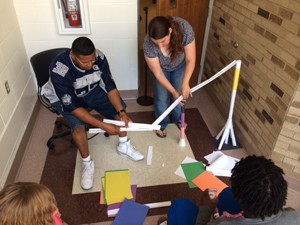
NSF Grant Helps Cincinnati Teachers Spend the Summer as Students
Fourteen school districts in the Cincinnati area are participate in a University of Cincinnati program called CEEMS (Cincinnati Engineering Enhanced Mathematics and Science Program). The program at UC has been made possible by a generous grant from the National Science Foundation (NSF). Its mission is to equip middle and high school science and math teachers with better strategies to engage students in math and science through engineering challenges.
Math and science are often difficult subjects to teach. Engaging middle and high school students is challenging due to the when will I ever use this mentality. CEEMS is working hard to change that attitude. Through challenge-based learning, CEEMS hopes to broaden the techniques of teaching STEM (Science Technology Engineering and Mathematics) education and show its real- world applications before students head off to college.
CEEMS Course: Applications of Technology

CEEMS teachers test their projects
Middle and high school teachers from all over the city trickle into the classroom at UC's Victory Parkway Campus for their third day of Applications of Technology. This is their second year in the CEEMS Program so they know what lies ahead. Conversations of yesterdays assignments quietly pick up until the entire room is buzzing.
In walks Professor Janak Dave, who teaches mechanical engineering at the University of Cincinnati. He is cheerful and alert as he sets up for the days lecture. Around 9:05 a.m., the class begins discussing the engineering design process. Professor Dave teaches everything from basic short cuts on Google Scholar, to potential activities the teachers can reenact with their students.
The engineering professor carefully connects the dots between engineering and secondary math and science classes. Each engineering problem is tailored to fit within the 7th to 2th grade classrooms. This seamless connection subtly prepares students to think like engineers.
Following a day lecture, the class prepares for an activity. Teachers are divided into groups and assigned their task. The groups spread out across the room and spill into the hallway. The mission at hand: build a structure, using only paper, cups, and straws that can guide a ping pong ball to the ground at the slowest speed. In the blink of an eye the room fills with competition and chaos. The challenge is refreshing after a day of lecture. Teams huddle together and design strategic plans to win first place.

The winning group tests their ping pong ramp
When the time comes to test their contraptions, each team carefully analyzes others' designs. They learn from others' mistakes and praise each other for their successes.
The next week of class brings more activities. In the same groups as before, the teachers repeat their huddles and try harder for a spot at first place. They research. They build. They collaborate. With each assignment, conversations revolve around ways they plan to use these activates in their own classrooms. Not a second of the day goes by without thinking of their students and the impact this new training will have.
On the final day of class, each teacher presents a lesson plan in their respective subjects. Nineteen teachers share their plans to engage their students with fun, interactive projects. They discuss their experience from the year before and share how they plan to improve the implementation of CEEMS units.
This group of teachers is truly remarkable. Not only do they dedicate themselves back to the classroom for seven longs weeks of their summer, but they do so with joy, knowing their students with reap the benefits.
Each CEEMS cohort goes through two years of training. As this group continues with their final classes, they look forward to the Closing Day Showcase on Aug. 1. Their efforts culminate into one event which gives them a chance to display their hard work and move into the academic year with a clear plan and readiness to impact their students.
Related Stories
Mayor Pureval, Rob Richardson lead ethical AI symposium
July 5, 2024
As artificial intelligence rapidly integrates into everyday life, Rob Richardson, CEO and founder of Disrupt Now and MidwestCon and local tech startup partner of the University of Cincinnati 1819 Innovation Hub, recently spearheaded the Responsible AI Symposium with Cincinnati Mayor Aftab Pureval, calling upon community leaders to discuss and ensure artificial intelligence technologies help users rather than harm.
UC’s microchip training includes innovative VR
July 2, 2024
To build a virtual microchip factory, University of Cincinnati doctoral students turned to the real one where they work. UC launched a new training program for microchip manufacturing in advance of the new fabrication plant Intel Corp. is opening in Ohio.
UC grad’s innovative tech to manage ER wait times
June 25, 2024
When launching Teravus, a health care triage management startup, Jason Murray turned to the University of Cincinnati's Center for Entrepreneurship and the 1819 Venture Lab for guidance and funding.
